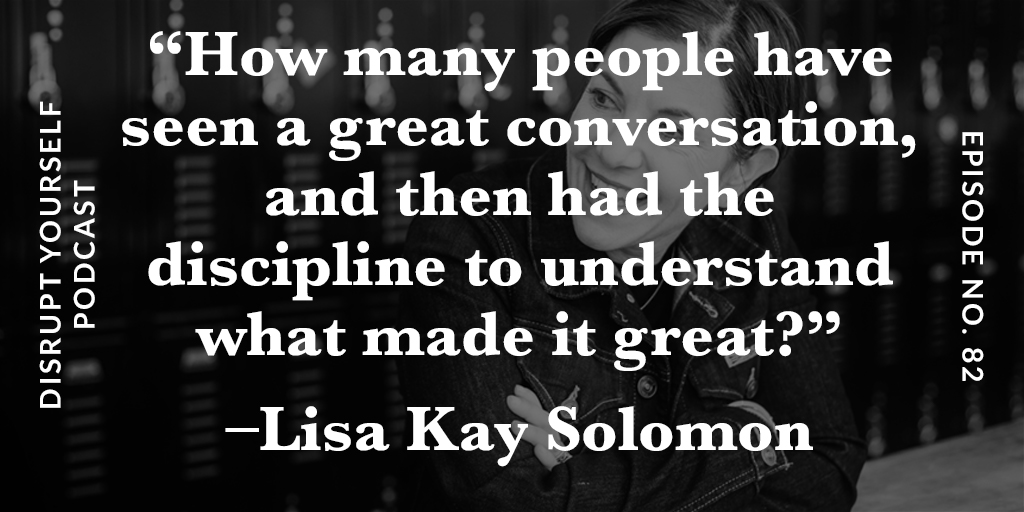Being the host of a podcast, I’ve had my share of great conversations, but I’ve also had some that were…not. Whether the blame should be placed on myself, my guest, or both of us, can be left up to interpretation, but I find it interesting that something we do every day—converse with others—is also something that we receive very little, if any, formal training in how to do well. Lisa Kay Solomon wants to change all that.
“Conversations are interactive, conversations have connectivity, conversations often start with generative questions, but we’ve never really been taught how to do it…How many people have seen a great conversation, and then had the discipline to understand what made it great…?”

Lisa is the author of Moments of Impact: How to Design Strategic Conversations That Accelerate Change, and she is passionate about great conversation. In the business world, this passion translates into a careful examination of team meetings and huddles, and Lisa is not afraid to shy away from the awful truth: most meetings are terrible. Americans spend (or waste) 1.2 billion hours every year in meetings, an average of four hours per week per person, and yet most employees feel that the most important discussions occur after a meeting is over, when discovery oriented conversations take place.
“We’re taught to manage meetings based on the constraints that we had, how much time do we have, who needs to be in the room, and what do we need to get decided…they design it from the bottom up without saying, “Hey, if we carve out the time that way, is that really gonna meet my goals? Is that really gonna get the job done?” So that can be the first and most important question that anybody listening can ask themselves.”
Instead of cramming an agenda into a too-small time frame, we can reverse-engineer what the successful outcome of the conversation will be. The trick, Lisa says, is all in the preparation: it takes at least three times the amount of time to prep for a conversation than you will have participating in the conversation, but if you carve out the time to prepare then those conversations will have more impact in five minutes than they would previously have had at fifty-five minutes.
Join us as Lisa explains how to facilitate great conversation, the usefulness of “question storming,” the four types of useless meetings. Listen on iTunes or in the player above. If you like what you hear, please leave a review!
Takeaways from this episode:
- Design thinking is a methodology that allows us to discover what job needs to be done and be open to understanding that a job to be done for our customer or user may be very different than the job we want And often the “job” is more emotional than logical.
- In the modern workforce, the model of a heroic leader who comes in and saves the company is no longer viable. We need to change our frame of leadership, making the leader a “condition creator” to support and be curious about what is going on around them and give their team the support they need to accomplish the company’s goals and amplify meaningful change.
- When you’re listening to someone, consider your stance: make sure it is open, with your shoulders square to the person you are speaking to and making eye contact (no looking at your phone!)
- Design conversations backwards: imagine yourself at the end of the conversation, and describe to yourself what has happened, and what the outcomes will be. What is the purpose of the conversation?
- Watch out for the four types of useless meetings: the Strongman Meeting; Military Meeting; Thousand Flower Meeting; and Groundhog Meeting.
- Conversations should be interactive and generate more questions, not simply jamming information into whoever is in the room.
- It is important that employees be aligned on the “why” of what they are doing; otherwise decisions that come from meetings will not be successful.
Links Mentioned in this Episode:
- Lisa Kay Solomon – Website | Twitter | LinkedIn
- Singularity University
- Design a Better Business by Patrick Van Der Pijl, Justin Lokitz, & Lisa Kay Solomon
- Moments of Impact: How to Design Strategic Conversations That Accelerate Changeby Lisa Kay Solomon and Chris Ertel
- Disrupt Yourself Podcast Episode 46 – Benjamin Hardy
- Willpower Doesn’t Work: Discover the Hidden Keys to Success by Benjamin Hardy
- The Singularity Is Near: When Humans Transcend Biology by Ray Kurtzweil
- XPRIZE
- The Power of Body Language by Joe Navarro
- TED
- Late Night with Stephen Colbert
- Creativity Rules: Inventing the Future
- Disrupt Yourself Podcast: Episode 58 – June Cohen
- Disrupt Yourself Podcast: Episode 73 – Harold O’Neal
- Build an A-Team: Play to Their Strengths and Lead Them Up the Learning Curve by Whitney Johnson
- Download a free chapter from Build an A-Team

